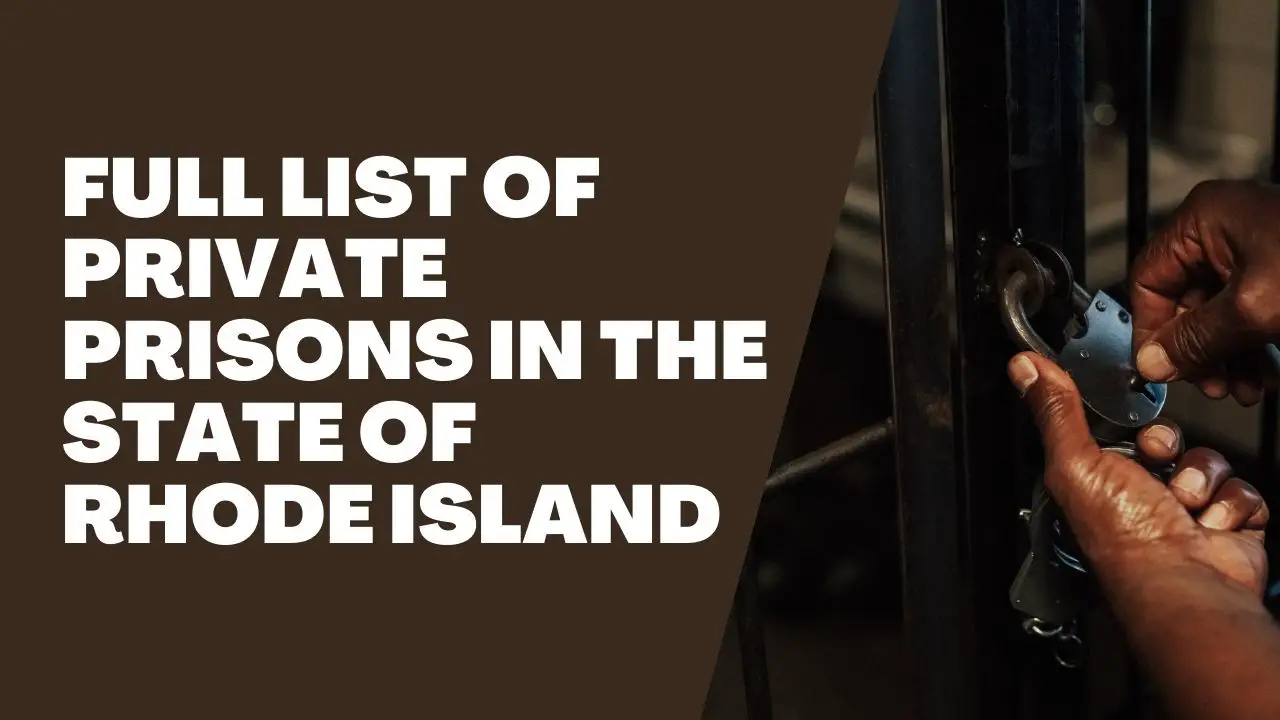Full List Of Private Prisons In The State Of Rhode Island
If you are looking for the list of private prisons in the state of Rhode Island, keep reading to know more!

Rhode Island is the smallest US state (by area) in the New England Region of the Northeastern US. It has only 1.1 million residents, making it the seventh-least populous state. However, it is the second-most densely populated state as over a million people live in 2,707 km2 of land area.
Considering the small population, the incarceration rates in Rhode Island are also quite low. The inmates are kept in jails and prisons throughout the state. Keep reading to learn about the list of private prisons in the state of Rhode Island, including other details.
Let’s dive in!
Prison Trends in Rhode Island
Rhode Island has an incarceration rate of 289 per 100,000 people. 2,500 people in the state are in jails and prisons. Considering the small number of incarcerations in Rhode Island, it only requires a limited number of prisons to manage the prison population.
2,200 inmates are in state prisons, while 210 serve time in federal prisons. At the same time, 110 individuals are in youth facilities. 18,000 of these prisoners are under probation, and 440 are under parole.
Read Full List Of Private Prisons In The State Of Pennsylvania
Prison Incarceration Rates
Prison incarceration rates in Rhode Island have increased significantly in the previous half a century. Prison incarceration trends show a continuous rise in imprisonments from 1978 to 1987 and a sudden increase until 1990.
The number again kept increasing until 1998 and dropped slightly in 1999. The incarcerations began increasing again, peaking in 2008 and falling in 2010.
Rhode Island Vs. National Average Vs. International Incarcerations
Rhode Island's incarceration rate of 289 is way less than the US national average incarceration rate of 664.
However, the number is still higher than many other democracies in the world, including the UK, which stands at 129 incarcerations per 100,000 population. Portugal, Canada, France, and a few other European countries follow the United Kingdom on the list.
Men Vs. Women
Men make up for the majority of imprisonments in the state, with an incarceration rate of 409 per 100,000. The total number of male inmates in Rhode Island is 2,094.
At the same time, the incarceration rate for women in the state is almost negligible, coming to around 11 per 100,000 population. The total population of women inmates is 62 in the Rhode Island prison system.
Read Full List Of Private Prisons In The State Of Oregon
Race/ Ethnicity
The race and ethnicity imprisonment trends in Rhode Island are similar to many other states, with Black incarcerations topping others. 1,884 Black offenders per 100,000 population serve time in Rhode Island jails and prisons, followed by 697 Hispanics and 446 American Indians.
The number of White inmates in the region reaches 210 per 100,000 people.
List of Private Prisons in the State of Rhode Island
Rhode Island is one of the states that do not use private prisons to manage the prisoner population.
The main reason for the list of private prisons in the state of Rhode Island to be blank is the negligible number of imprisonments. The state does not require additional help to keep the offenders.
But we have compiled a list of Rhode Island prisons for you in this article.
Prisons in Rhode Island
Rhode Island is one of the six states with unified systems, combining state prisons and jails into one department. Here are the prisons and jails in the state of Rhode Island:
Anthony P. Travisono Intake Service Center
The Anthony P. Travisono Intake Service Center is a maximum-security jail for male inmates in Rhode Island. The construction of the South wing of the building finished in 1982, followed by the North wing in 1992.
This jail can keep 1,148 inmates for 27 days on average before they are moved to other facilities. The Anthony P. Travisono Intake Service Center processes and transfers 20 inmates to other facilities weekly.
This facility keeps the inmates in different categories, including newly sentenced inmates, pretrial detainees, and sentenced protective custody.
Opened in: 1982
Inmate capacity: 1,148
Annual cost per offender: $81,584
Facility address: 18 Slate Hill Road, Cranston, RI 02920
Mail address: PO Box 8249, Cranston, RI 02920
John J. Moran Medium Security Facility (MED)
The John J. Moran Medium Security Facility was established between 1990 and 1992. MED is the largest prison, spread over 29 acres, with the capacity to keep 1,186 inmates.
This medium-security prison prepares the prisoners to return to the community. The inmates can enroll in a license plate shop, a garment and furniture/upholstery shop, or the auto body shop.
Opened in: 1992
Inmate capacity: 1,186
Annual cost per offender: $82,236
Facility address: 51 West Road, Cranston, RI 02920
Mail address: PO Box 8274, Cranston, RI 02920
The High Security Center
As the name suggests, the High Security Center (HSC) is a high-security facility that houses offenders that require close observation and maximum control. The facility has a bed capacity of 166 and offers various programs at the Rehabilitation Treatment Unit (RTU).
The High-Security Center also has a recreational legal library, a classroom, and a classification board room.
Opened in: 1981
Inmate capacity: 166
Annual cost per offender: $225,259
Facility address: 54 Power Road, Cranston, RI 02920
Mail address: PO Box 8200, Cranston, RI 02920
The Maximum Security Facility (MAX)
The Maximum Security Facility is the oldest operational prison in Rhode Island, opened in 1878. All the inmate cells in this facility are in one building; the facility can accommodate 466 inmates. The prison also employs 190 inmates to help manage the functions.
This prison housed both sentenced and awaiting offenders, but now the prison needs have changed with the addition of other facilities. The prison population includes inmates transferred to the Maximum Security Facility from other facilities due to discipline issues. It also keeps prisoners serving long sentences for different offenses.
Opened in: 1878
Inmate capacity: 466
Annual cost per offender: $100,909
Facility address: 1375 Pontiac Avenue, Cranston, RI 02920
Mail address: PO Box 8273, Cranston, RI 02920
Minimum Security Facility
The Minimum Security Facility opened in 1978, is built in a converted hospital building. The prison expanded in 1989 and 1992, with an additional 710-bed facility.
This facility also employs the prisoners on public service projects, at Work Release Program sites, and within the institution.
Opened in: 1989
Inmate capacity: 710
Annual cost per offender: $157,267
Facility address: 16 Howard Avenue, Cranston, RI 02920
Mail address: PO Box 8212, Cranston, RI 02920
Gloria McDonald Women’s Facility
The Gloria McDonald Women’s Facility is the only women's facility in Rhode Island, with a capacity of 187 inmates.
It opened in 2010 in a converted hospital building. While it was initially meant to be a male Reintegration Center, the prison now keeps minimum, medium, and work-release prisoners besides inmates awaiting trial offenders.
Opened in: 2010
Inmate capacity: 187
Annual cost per offender: $170,296
Facility address: 20 Fleming Road, Cranston, RI 02920
Mail address: PO Box 8312, Cranston, RI 02920
Besides the five functional prisons in Rhode Island, two prisons have been closed:
- Bernadette Building
- Donald Price Medium Security Facility
Final Words
Rhode Island is the smallest US state by area and the seventh-least populous state. It is the second-most densely populated state as over a million people live in 2,707 km2 of land area. Considering the small population, the incarceration rates in the state are also quite low. Rhode Island has an incarceration rate of 289 per 100,000.
The list of private prisons in the state of Rhode Island is blank because of the low incarceration rates. The state does not require help from private facilities to manage the prisoner population.
